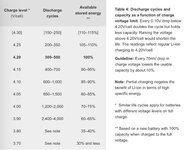Oski1997
Active Member
- Region
- USA
- City
- San Diego
Ravi, depth of discharge seems to be the main factor that contributes to a significant loss of cycles (after temperature factors, of course). In this graph (see pic) it shows that I would get 1,000 cycles when using a Depth of Discharge of 80%-85% (which I believe means using a battery from 90%-10% or 90%-15%). This is a 75% loss in battery capacity compared to using a DoD of 60-65% (charging up to 80% and using it down to 40%) which would give me 4,000 cycles. Are you saying that regardless of these figures our ebike batteries will only give us 1,500 cycles no matter what because of Calendar Aging? We should disregard these numbers? Doesn’t this study support the notion that I could get 4,000 cycles in each battery if I only charge them up to 80% and use them down to 40%? Or is this just theoretical?I agree with @AHicks . If you are not actively using the 2nd battery, then you may not see a huge benefit by alternating the batteries.
May I ask you this?
How many miles do you ride per year?
With proper care, Yamaha batteries can serve you well for 30,000 miles or more. So, that's like 3-4 years of heavy riding.
if you get 30 miles per charge cycle (cycling between 85% to 15% should give you 1500 usable cycles) and that's 30 X 1500 = 45,000 miles.
By alternating another battery, you can not prolong that number to 80,000 miles because of the inherent calendar aging.
Attachments
Last edited:
